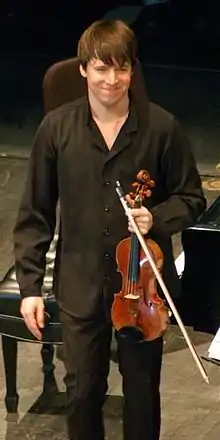Gibson Stradivarius
The Gibson ex-Huberman Stradivarius of 1713 is an antique violin made by Antonio Stradivari of Cremona. The Gibson, while owned by Bronisław Huberman, was stolen twice. The first time it was returned shortly afterward. The second theft, possibly by musician Julian Altman, occurred on the evening of 28 February 1936, backstage at Carnegie Hall, while Huberman performed with his Guarnerius of 1731.

Though Huberman never saw the Gibson again, it was recovered 50 years later, in 1985, as a result of Altman's deathbed confession to his wife that he had bought the stolen violin from a friend for $100.[1] In 1988 she turned it in to Lloyd's, which paid her a $263,000 finder's fee and then sold it for $1.2 million to Norbert Brainin, an acclaimed English violinist.
It is currently owned by violinist Joshua Bell. Bell had played the violin, and Brainin jokingly told him it could be his for four million dollars. Shortly thereafter, by chance, Bell came across the violin again and discovered it was about to be sold to a German industrialist to become part of a collection. According to his website, Bell "was practically in tears."
Bell sold his then current Stradivarius, the Tom Taylor, for a little more than two million dollars and purchased the Gibson ex-Huberman for a little under the four million dollar asking price. His first recording with it was Romance of the Violin (on Sony Classical) in 2003.
In 2019, the instrument's value increased to an estimated $14 million.[2]
References
- Madden, Richard L. (14 May 1987). "A Stolen Stradivarius, A 51-Year Old Secret". The New York Times. Retrieved 2 February 2014.
- Hinson, Mark (January 24, 2019). "Meet Joshua Bell, the man with the $14-million violin". Tallahassee Democrat. Retrieved 2021-10-04.
Further reading
- Chaudière, Frédéric (2013). A Strad out of the blue - The incredible journey of the Gibson Stradivarius. Montpellier: FHC Editions. ISBN 9782954746807.